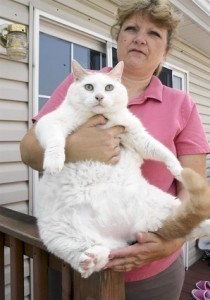Worlds Biggest Cat
Known scientifically as Felis catus, the cat is often referred to as housecat or  domestic cat to differentiate it from other felids and felines. Although small, this carnivorous mammal is valuable to humans because of its capacity to hunt household pests and vermin. Furthermore, it serves as a highly important companion for people inside the house. Today, it is regarded as the most popular pet worldwide over dogs and other animals. Aside from these interesting facts, it is also good to learn something about the world’s biggest cat.
domestic cat to differentiate it from other felids and felines. Although small, this carnivorous mammal is valuable to humans because of its capacity to hunt household pests and vermin. Furthermore, it serves as a highly important companion for people inside the house. Today, it is regarded as the most popular pet worldwide over dogs and other animals. Aside from these interesting facts, it is also good to learn something about the world’s biggest cat.
The Biggest Cat in the World
Based on the Guinness Book of World Records, the largest domestic cat ever recorded came from the state of Queensland in Australia. Named Himmy, the cat weighed more than 46 pounds or 20.87 kilograms. Its length measured 38 inches or 96.52 centimeters, its waist 33 inches or 83.82 centimeters and its neck 15 inches or 38.1 centimeters.
Today, there is another large cat in contention for the world’s biggest cat. Named Katy, it can be found in Russia. It weighs 44.09 pounds or 20 kilograms. However, the Guinness Book of World Records reportedly stopped accepting nominations for such category in order not to encourage pet owners to overfeed their cats.
Additional Facts and Other Interesting Details
In terms of breed, the Maine Coon is probably one, if not the largest. It can weigh more than 25 pounds or 11 kilograms. The average height of cats is 23 to 25 centimeters or 9.06 to 9.84 inches. The average length of tails is 30 centimeters or 11.8 inches.
Cats are known for their keen senses. Their night vision is remarkable, which functions only about 1/6th of the light level necessary for human beings in order to see clearly. The sensitivity of their eyes to dim light is enhanced significantly because of their eyes have tapetum lucidum. However, they have very poor color vision, which allows them to see only two different colors, namely green and blue.
Aside from their remarkable sight, they are also notable for their excellent hearing. In fact, they can identify an extremely wide range of frequencies. They possess better hearing than humans or dogs. In terms of life span, indoor cats usually last for about 14 to 20 years in captivity. This kind of animal is susceptible to different kinds of health problems including injuries, parasites as well as infectious diseases.
Cat owners must keep their pets away from certain objects, which are proven hazardous to the health of cats. These include weed killers, insecticides and rodenticides. Furthermore, they must be kept away from ethylene glycol, naphthalene and mothballs.





